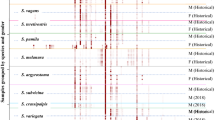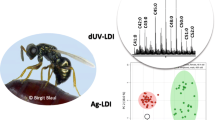Abstract
Insect cuticular hydrocarbons are usually species-specific mixtures and may serve for species and gender recognition. They are, therefore, widely used in the chemotaxonomy and zoogeography of various insect taxa. In order to provide a basic study for further comparative analyses of cuticular hydrocarbon (CHC) profiles of cryptic species hidden within the South American fruit fly Anastrepha fraterculus complex (Diptera: Tephritidae), we analyzed the composition of the CHCs and their production with respect to age and sex in a laboratory population from Tucuman, Argentina. Several techniques of gas chromatography with mass spectrometric detection have been used in order to develop a suitable method for CHC identification, i.e., GC-MS in EI mode, GC-MS in CI mode, and GC×GC/TOFMS. Our analyses revealed a complex profile of aliphatic hydrocarbons in both males and females, consisting predominantly of n-alkanes, methyl-branched alkanes, as well as of alkenes and alkadienes. In young individuals (up to about 5 days after emergence), the CHC profiles were similar in males and females. However, in older flies, these profiles diverged and became clearly sex-specific. The temporal dynamics of the CHC patterns in both sexes were evaluated using multivariate exploratory techniques.



Similar content being viewed by others
References
Aitchison, J. 1986. The statistical analysis of compositional data. Chapman and Hall, London.
Aluja, M. and Norrbom, A. L. 2001. pp. 731–749, Fruit Flies (Tephritidae): Phylogeny and evolution of behavior. CRC Press, Boca Raton, Florida.
Blomquist, G. J. and Bagnères, A. G. 2010. Insect hydrocarbons. Biology, Biochemistry and Chemical Ecology. Cambridge University Press, USA.
Brown, W. V., Morton, R., and Spradbery, J. P. 1992. Cuticular hydrocarbons of the Old World screw-worm fly, Chrysomya bezziana Villeneuve (Diptera: Calliphoridae). Chemical characterization and quantification by age and sex. Comp. Biochem. Physiol. A. 101:665–671.
Caputo, B., Dani, F. R., Horne, G. L., Petrarca, V., Turillazzi, S., Coluzzi, M., Priestman, A. A., and Torre, A. 2005. Identification and composition of cuticular hydrocarbons of the major Afrotropical malaria vector Anopheles gambiae s.s. (Diptera: Culicidae); analysis of sexual dimorphism and age-related changes. J. Mass Spectrom. 40:1595–1604.
Carlson, D. A. and Yocom, S. R. 1986. Cuticular hydrocarbons from six species of Tephritid fruit flies. Arch. Insect Biochem. Physiol. 3:397–412.
Carlson, D. A., Roan, C. S., Yost, R. A., and Hector, J. 1989. Dimethyl disulfide derivates of long chain alkenes, alkadienes, and alkatrienes for gas chromatography/mass spectrometry. Anal. Chem. 61:1564–1571.
Carlson, D. A., Bernier, U. R., and Sutton, B. D. 1998. Elution patterns from capillary GC for methyl-branched alkanes. J. Chem. Ecol. 11:1845–1865.
Chenoweth, S. F. and Blows, M. W. 2005. Contrasting mutual sexual selection on homologous signal traits in Drosophila serrata. Am. Nat. 165:281–289.
Geislhardt, S., Otte, T., and Hilker, M. 2009. The role of cuticular hydrocarbons in male mating behavior of the mustard leaf beetle Phaedon cochleariae (F.). J. Chem. Ecol. 35:1162–1171.
Goh, S. H., Ooi, K. E., Chuang, C. H., Yong, H. S., Khoo, S. G., and Ong, S. H. 1993. Cuticular hydrocarbons from two species of Malaysian Bactrocera fruit flies. Biochem. Syst. Ecol. 21:215–226.
Gomez, C. P., Calcagno, G., Belluscio, L., and Vilardi, J. C. 2011. Male courtship behavior of the South American fruit fly, Anastrepha fraterculus, from an Argentinean laboratory strain. J. Insect Sc. 11:175.
Grillet, M., Dartevelle, L., and Ferveur, J. F. 2006. A Drosophila male pheromone affects female sexual receptivity. Proc. Biol. Sci. 273:315–323.
Hernandez, V. H., Gomez-Anaya, J. A., Sanchez, S., Mcpheron, B. A., and Aluja, M. 2004. Morphometric analysis of Mexican and South American populations of the Anastrepha fraterculus complex (Diptera: Tephritidae) and recognition of a distinct Mexican morphotype. Bull. Entomol. Res. 94:487–499.
Hernández-Ortiz, V. and Aluja, M. 1993. Listado de especies del género neotropical Anastrepha (Diptera: Tephritidae) con notas sobre su distribución y plantas hospederas. Folia Entomol. Mexic. 88:89–105.
Howard, R. W. and Blomquist, G. J. 2005. Ecological, behavioral, and biochemical aspects of insect hydrocarbons. Annu. Rev. Entomol. 50:371–393.
Kaltenpoth, M., Kroiss, J., and Strohm, E. 2007. The odor of origin: kinship and geographical distance are reflected in the marking pheromone of male beewolves (Philanthus triangulum F., Hymenoptera, Crabronidae). BMC Ecol. 7:1–11.
Kather, R. and Martin, S. 2012. Cuticular hydrocarbon profiles as a taxonomic tool: advantages, limitations and technical aspects. Physiol. Entomol. 37:25–32.
Kováts, E. 1965. Gas chromatographic characterization of organic substances in the retention index system. Adv. Chromatogr. 1:229–247.
Kroiss, J., Svatoš, A., and Kaltenpoth, M. 2011. Rapid identification of insect cuticular hydrocarbons using gas chromatography-ion-trap mass spectrometry. J. Chem. Ecol. 37:420–427.
Lavine, B. K., Carlson, D. A., and Calkins, C. O. 1992. Classification of Tephritid fruit fly larvae by gas chromatography/pattern recognition techniques. Microchem. J. 45:50–57.
Lima, I. S. and Howse, P. E. 1997. Diurnal activity and sexual maturation of the South American fruit fly (Diptera: tephritidae) in the laboratory. Ann. Soc. Entomol. Brasil 26:299–308.
Lima, I. S., House, P. E., and Salles, L. A. B. 1994. Reproductive behaviour of the South American fruit fly Anastrepha fraterculus (Diptera: Tephritidae): laboratory and field studies. Physiol. Entomol. 19:271–277.
Lima, I. S., House, P. E., and Do Nascimento, R. R. 2001. Volatile substances from male Anastrepha fraterculus Wied. (Diptera: Tephritidae): identification and behavioural activity. J. Brazil. Chem. Soc. 12:196–201.
Malavasi, A. and Morgante, J. S. 1982. Genetic variation in natural populations of Anastrepha (Diptera: Tephritidae). Rev. Bras. Genet. 5:263–278.
Morgante, J. S., Malavasi, A., and Bush, G. L. 1980. Biochemical systematics and evolutionary relationships of neotropical Anastrepha. Ann. Entomol. Soc. Am. 73:622–630.
Morgante, J. S., Malavasi, A., and Prokopy, R. J. 1983. Mating behavior of wild Anastrepha fraterculus (Diptera: Tephritidae) on a caged host tree. Fla. Entomol. 66:234–241.
Mpuru, S., Blomquist, G. J., Schal, L. C., Roux, M., Kuenzli, M., Dusticier, G., Clement, J. L., and Bagnères, A. G. 2001. Effect of age and sex on the production of internal and external hydrocarbons and pheromones in the Housefly. Musca domestica. Insect Biochem. Mol. Biol. 31:935–935.
Perez-Mendoza, J., Dowell, F. E., and Broce, A. B. 2002. Chronological age-grading of house flies by using near-infrared spectroscopy. J. Med. Entomol. 39:499–508.
Pomonis, J. G., Fatland, C. L., Nelson, D. R., and Zaylskie, R. G. 1980. Insect hydrocarbons corroboration of structure by synthesis and mass spectrometry of mono- and dimethylalkanes. J. Chem. Ecol. 4:27–39.
Reeves, W. K., Peiris, K., Scholte, E. J., Wirtz, R. A., and Dowell, F. E. 2010. Age-grading the biting midge Culicoides sonorensis using near-infrared spectroscopy. Med. Vet. Entomol. 24:32–37.
Rouault, J. D., Marican, C., Wicker-Thomas, C., and Jallon, J. M. 2004. Relations between cuticular hydrocarbon (HC) polymorphism, resistance against desiccation and breeding temperature; a model for HC evolution in D. melanogaster and D. simulans. Genetica. 12:195–212.
Segura, D., Petit-Marty, N., Sciurano, R., Vera, T., and Calcagno, G. 2007. Lekking behavior of Anastrepha fraterculus (Diptera: Tephritidae). Fla. Entomol. 90:154–162.
Selivon, D. 1996. Estudo sobre a diferenciação populacional em Anastrepha fraterculus (Wiedemann) (Diptera, Tephritidae). Ph.D. dissertation. Universidade de São Paulo, São Paulo, Brasil.
Solferini, V. N. and Morgante, J. S. 1987. Karyotype study of eight species of Anastrepha (Diptera, Tephritidae). Caryologia 40:229–241.
Steck, G. J. 1991. Biochemical systematics and population genetic structure of Anastrepha fraterculus and related species (Diptera: Tephritidae). Ann. Entomol. Soc. Am. 84.
Steck, G. J. 1999. Taxonomic status of Anastrepha fraterculus. The South American fruit fly, Anastrepha fraterculus (Wied.): advances in artificial rearing, taxonomic status and biological studies. International Atomic Energy Agency, Austria. http://www-naweb.iaea.org/nafa/ipc/public/TECDOC_1064
Steck, G. J. and Sheppard, W. S. 1993. Mitochondrial DNA variation in Anastrepha fraterculus. pp. 9–14 in M. ALUJA and P. LEIDO (eds.). Fruit Flies: Biology and Management. Springer-Verlag, New York. USA.
Strohm, E., Kroiss, J., Herzner, G., Laurien-Kehnen, C., Boland, W., Schreier, P., and Schmitt, T. 2008. A cuckoo in wolves’ clothing? Chemical mimicry in a specialized cuckoo wasp of the European beewolf (Hymenoptera, Chrysididae and Crabronidae). Front. Zool. 5:2.
Sutton, B. D. and Carlson, D. A. 1993. Interspecific variation in Tephritid fruit fly larvae surface hydrocarbons. Arch. Insect Biochem. Physiol. 23:53–65.
Sutton, B. D. and Steck, G. J. 1994. Discrimination of Caribbean and Mediterranean fruit fly larvae (Diptera: Tephritidae) by cuticular hydrocarbon analysis. Fla. Entomol. 77:231–237.
Thomas, M. L. and Simmons, L. W. 2008. Cuticular hydrocarbons are heritable in cricket Teleogryllus oceanicus. J. Evol. Biol. 21:801–806.
Vrkoslav, V., Muck, A., Cvačka, J., and Svatoš, S. 2010. MALDI imaging of neutral cuticular lipids in insects and plants. J. Am. Soc. Mass. Spectr. 21:220–231.
Zucchi, R. A. 2000. Espécies de Anastrepha, sinonímias, plantas hospedeiras e parasitóides, pp. 41–48, in A. Malavasi and R. A. Zucchi (eds.), Moscas-das-Frutas de Importância Econômica no Brasil: Conhecimento Básico e Aplicado. Holos Editora, Ribeirão Preto, Brazil.
Zucchi, R. A. 2007. Diversidad, distribution y hospederos del género Anastrepha en Brasil, pp. 77–100, in V. Hernández-Ortiz (ed.), Mosca de la fruta en Latinoamérica (Diptera: Tephritidae): diversidad, biología y manejo. S y G editores, Distrito Federal, Mexico.
Acknowledgments
We thank Dr. Andrew Jessup and Dr. Jorge Hendrichs from the International Atomic Energy Agency for kindly providing us with the insect. We acknowledge Dr. Robert Hanus (Infochemicals Research Team, IOCB, Czech Republic) for valuable comments on the manuscript. Financial support was provided by the Academy of Sciences of the Czech Republic (subvention for development of research organization RVO: 61388963), the International Agency for Atomic Energy, United Nations, Vienna (Research Contracts No. 16106 and 16051), and the Max Planck Society. We thank Sybille Lorenz (Research Group Mass Spectrometry, ICE-MPI, Germany) and RNDr. Anna Březinová (Research Group Mass Spectrometry, IOCB, Czech Republic) for their skillfull assistance with the GC-MS experiments.
Author information
Authors and Affiliations
Corresponding author
Rights and permissions
About this article
Cite this article
Vaníčková, L., Svatoš, A., Kroiss, J. et al. Cuticular Hydrocarbons of the South American Fruit Fly Anastrepha fraterculus: Variability with Sex and Age. J Chem Ecol 38, 1133–1142 (2012). https://doi.org/10.1007/s10886-012-0177-8
Received:
Revised:
Accepted:
Published:
Issue Date:
DOI: https://doi.org/10.1007/s10886-012-0177-8




